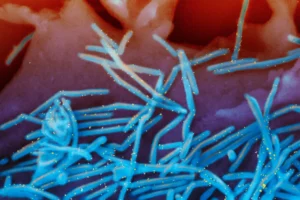Author Explains How Human Traffickers Target Vulnerable Teens
Advises parents to monitor their children’s online activities
- Published In: Other News & Features
- Last Updated: Dec 30, 2022

By Jennifer Kocher
Special to the Wyoming Truth
Retired certified public accountant and author John DiGirolamo knew nothing about human trafficking until a fateful conversation with a police officer in 2020. His retirement that year coincided with the defund the police movement sparked by the national outcry over the death of George Floyd—and the uproar didn’t sit well with him.
So DiGirolamo, of Chaffee County in Colorado, decided to portray the human side of policing in his first book, “It’s Not About the Badge” (Deer Track Publishing, 2021).The book examines the lives of six rural and suburban police officers throughout the Mountain West. It was during an interview with a Chaffee County Sheriff Sergeant, who asked to remain anonymous, that DiGirolamo learned about human trafficking.

DiGirolamo, 57, asked the officer what he would do if he won the lottery, expecting the pat answer: “Quit my job and never work again.” Instead, he received a surprising response. The sergeant said he’d quit his job and spend the rest of his life hunting down human traffickers. The passion in his voice prompted DiGirolamo to research human trafficking and attend several prevention trainings. DiGirolamo’s new book, “It’s Not About the Sex” (itsnotabout.com, 2022), tackles the subject from four different perspectives: that of a police officer, mental health advocate, a survivor and a former brothel madam.
The first section of DiGirolamo’s book features police case files about the sex trafficking of teenage girls in Colorado. These stories reflect what the author calls the “predator’s playbook” that’s used to lure vulnerable teens. In one case, a predator in his 40s befriended a 15-year-old girl on an online gaming site. They talked online for several weeks before he invited her to meet him at a local mall. Despite noting that he lied to her about his age, the teen agreed to be friends with him after he bought her new clothes. At their second meeting, the predator gave her OxyContin pills followed by methamphetamine. Within weeks, the teen was addicted, and the predator was able to exploit her in exchange for sex.
DiGirolamo found these patterns troubling, and now he wants to share what he’s learned with parents and teens.
The Wyoming Truth recently spoke with DiGirolamo about human trafficking and how parents can keep their children safe from online predators. What follows are excerpts from the interview.
What surprised you the most about human trafficking?
DiGirolamo: I learned these are not isolated stories. Most people visualize human trafficking as occurring on the southern border, but it is happening everywhere. When I was doing my research, people thought it didn’t happen in small towns and suburbs, but it [does]. It happens everywhere—and more often than you think. The majority of teens are being groomed by someone they know. It’s not just females, either. It happens to boys 45% of the time. It also happens in nice communities. Many predators are also living among us. They can appear to be just regular people who might be married and living right down the street.
What are some techniques from the “predator’s playbook” that you saw in the police files?
DiGirolamo: In some cases, predators are creating fake social media profiles impersonating teenage boys. They are approaching teens [through] online games and tend to target vulnerable teens, especially those in the foster care system. Sometimes, guys approach teens at Starbucks or a fast-food restaurant. They target teens who are lonely and forge a friendship. They might spend a month trying to gain their trust. That’s common. Once they coerce them, they start using that control to traffic them. In many cases, they use drugs to exploit these vulnerabilities. Predators also try to isolate victims from friends and family. If your parents don’t love or understand you, the predator is there for you. They step in to fill that void. They target teenage boys by creating [fake] accounts with good-looking college girls who quickly send nude photos of themselves, asking the boys to send photos in return. Then, the teens end up getting exhorted by threats to share those photos with their family and friends. This happens to adults and teens.
How does technology factor into trafficking?
DiGirolamo: Technology has allowed predators to find people. Now, the “stranger danger” is all internet-based. It’s easy to set up [social media] profiles. The pandemic drove more kids online when they couldn’t socialize. Just because the child is sitting at the dinner table or up in their bedroom doesn’t mean that they are safe. Predators are just going to throw out as many darts as they can until they get a victim.
How can parents protect their children?
DiGirolamo: One of the things they can do is monitor their child’s online activity. Check on what they are doing. There are some parental control applications [to monitor online activity], but those are guardrails. Teens are savvy, and there’s all kinds of ways to circumvent the control, including the calculator app that works like a calculator but also has secret folders. There’s also a “My eyes only” tool on Snapchat where kids can keep photos secret. If you don’t know those kinds of things, you’re easily fooled.
Parents should also be in control of all of their passwords and apps. It requires more parenting in modern times, and people are busy and seem to parent less. But predators have a handbook, and they are there to fill the void. Teens are building their self-esteem through likes on social media. They are living online in that way and perpetuating their social life and drama. It’s a vicious cycle, and they get these quick dopamine hits when they get positive attention. It leaves them wanting more. Sometimes the process of being exhorted can take less than 24 hours, and parents really need to be vigilant.
What are the warning signs that teens are being targeted?
DiGirolamo: Behavioral changes. They might become super defiant or withdrawn and depressed. Part of the predator handbook is to isolate the teens or adult from their friends and family. These behavior changes can mean a whole lot of things, but if a teen starts acting out or abusing substances, these could be indications of trafficking. A lot of times parents are in their own kind of survival mode and are not picking up the signs.













